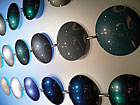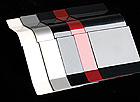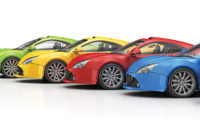
BASF Coatings Designers Present 2008 Color Trend Forecast for the Automotive Industry
The debate on climate protection and heightened environmental awareness is impacting color trends for cars. “The worlds of color reflect a sustainable symbiosis of nature and technology,” declared BASF Coatings color designers Michaela Finkenzeller and Mark Gutjahr (Europe), Chiharu Matsuhara (Asia/Pacific) and Sandra Mathia (North America) at the presentation of the 2008 color trend forecast for the automotive industry. The new palette of colors, inspired by ecological developments, ranges from new blacks, the trend color white in its multifaceted variations, rich blues and greens, all the way to pastel colors. And the new silver is nothing like the silver of yesterday, which for years was the dominant color for cars all over the globe. Its frosty and cool or highly reflective surfaces (Liquid Metal), as well as its ethereally tinted nuances, are absolutely inspiring.“Ecology has become the trendsetter of the future, and in a number of areas has brought about a complete shift in thinking. Whether it’s buying habits, research or driving, sustainability is the name of the game,” said Finkenzeller and Gutjahr, who base their assessment of current trends on their observations of society. They added that the triangle of tensions involving individualism, ecology and technological progress is leading to new worlds of color that exploit their potential down to the last nuance.
Europe
Silver, White, and Blues and Greens – a Color Palette Inspired by Ecology
Silver is seeing huge changes. The sheen of the up-and-coming eco-efficient technologies is nothing like the technical silver of yesterday. Here, the interplay of physical states unfolds, challenging the senses. The colors range from ethereal tinted silver nuances, in some cases with frosty and cool surfaces, to highly reflective liquid-metal effects. These colors visualize new technologies of the future that we can only begin to dream of at the moment.
Of course, when it comes to seamless functionality and maximum efficiency, the trend color white in its multifaceted variations is indispensable. This is where technology and the aesthetics of purity and perfection become one.
Ideas of purity and clarity, together with associations of crystal-clear water and fresh, pristine air, are the inspiration for the healthy and rich colors of blues and greens. “These are the original colors they sing about in ballads. They tell of an ideal world and the harmony between man and nature,” Finkenzeller and Gutjahr explained.
Black – Fear and Fascination
When it comes to the future, fear of the unknown is often lurking in the background. The extent to which this can be expressed is demonstrated by the new color palette that stretches from fear to fascination. The need for protection is at the very core of the dark metallic colors. Cool yet mystically gleaming surfaces command awe and respect. These new blacks in deep, graduated shades with subtle effects offer extraordinary emotionality at outer limit of the color spectrum.
Sheer Pleasure With Colors – New Effects
In contrast to black, a countertrend is sending the message “Colors should be fun.” New effects, aluminum flakes and extreme sparkles seem to need no more than a smidgeon of light to unfold their full radiance. The flakes and pigments practically set off fireworks on the surface.
Color Oasis With a Feel-Good Factor – Pastel Colors
Seductive softness makes these light colors, which have a high percentage of white, irresistible. Linked to all aspects of physicality, haptics and wellness, these colors call up a sensation of luxury. They’re colors for the senses!
Color Trends in Asia/Pacific
Floating White
White, specifically pearl white, is extremely popular in the Asia/Pacific region. In the Asian culture, white stands for purity and innocence. In addition to this traditional image, white evokes luxury and has become popular as a classic color. Furthermore, in recent years white has taken on a nearly futuristic image and stands for progressive technologies, and evokes environmental friendliness and cleanliness. In the Japanese market, which has a long history of white pearl, floating white pearl with nuance and romantic interference will emerge. This color symbolizes the mixture of our expectations and anxiety for the future.
Evolved Black, Silver and Grey
There will be an evolution in black, silver and grey. This everlasting color area in automotive colors will be reborn by the new technologies. The variation will be slightly brighter shades or muted, iridescent and silky effects.
Surface Effects
Surface effects are gaining in importance. “Three-dimensional” effects are in demand. Colors like Liquid Metal, with major iridescent effects, deep and especially bright colors, and special, futuristic surfaces such as magical semi-transparent surfaces will be commanding attention.
Color Trends in North America
White
White is simple. White is clean. White is changing. New white concepts show matte finishes and tri-coat applications with slight hue shifts, which bring forth a yellow-gold influence.
Silver/Gray
Silver evokes the sparkle and glitter of Hollywood. Adding large, coarse flakes to extreme liquid silver evokes a technical and futuristic realm. New grays will show added hints of cool color in the form of steel blues, fashion pinks and deep purples.
Black
Black is evolving with new effects. Adding flakes to a basecoat changes everything, bringing forth dark, rich jewel tones of deep cherry red and midnight blue. Midnight blue is expected to peak for model years 2009 - 2010.
Red
Red is still hot. New reds have hues ranging from yellow to blue and from sport to luxury. A resurgence of tinted clears paired with red is expected for future model years.
Blue
The color blue stands for nature and is considered to be a soothing element. Blue is safe, serene and spiritual. Blue continues to ascend in popularity in all hues and depths. Some of the most popular blues for 2008 include ice blues, spa blues and navy blues.
Green
In the automotive color world, green plays only a minor role. However, the future of green should not be underestimated. Green speaks of life and nature. Green evokes the environment and sustainability. Today’s green has staying power by reinventing itself. And when paired with blue to create the effect of a stormy sea, green may be unstoppable.
Neutral Colors
The percentage of neutral colors is likely to increase in the next few years. Warm, earth-based neutrals with hue movement will also increase in popularity as they are influenced by the environmental movement and Hollywood trends. They reflect the matte gold of fashion and jewelry. Richer mahogany colors are influenced by dark wood furnishings. The warmest of earth-toned neutrals range from vibrant orange to smooth copper and brilliant bronze.

DuPont Reports Global Color Popularity Ratings for Vehicles
Silver is no longer the undisputed color champion of the automotive world, according to the DuPont 2007 Global Automotive Color Popularity Report. After seven years in first place, silver ran into tough competition this year with white/white pearl rising to the lead color choice for vehicles in one key region and two countries.In North America, white/white pearl, silver and black/black effect are in a virtual tie for first, with white/white pearl narrowly taking the top spot, according to the report issued by the company’s Automotive Systems business. White overcame silver in Japan and is the decisive leader in Mexico, more than doubling the popularity of gray.
DuPont has tracked color statistics for more than 55 years and reports converging trends in color preference. This year, DuPont sees white/white pearl as a trend-shifting color, and anticipates the new black metallic and other color effects will show an increase in popularity over time. Red also continues to gain ground and is ensuring a more vividly colored outlook in nearly all segments.
“Our customers are looking at niche colors and effects, including matte finishes and warm neutrals with effect,” said Karen Surcina, Color Marketing and Technology Manager – DuPont Automotive Systems. “The rise in popularity of white/white pearl and the long reign of silver suggest that we can expect a more dramatic shift in the top color choice.”
“We are not surprised to see a proliferation of white/white pearl in DuPont’s report this year,” said Leatrice Eiseman, Executive Director of the Pantone Color Institute and author of Color: Messages and Meanings. “It follows the global trends in home furnishings, fashion, consumer products and industrial design where we’re seeing a return to white as a clarifying agent before change, a color of purity and minimalism,” Eiseman said. “White also is considered a fashion statement. The car you drive is a fashion statement, and consumer preferences for white agree. White pearl itself is a combination of many colors, allowing an ability to change, reflecting, in effect, layers of white.”
This year’s DuPont Global Color Automotive Popularity Report tracks color across vehicle segment and also reports by geographic region. New for 2007, Mexico and Brazil vehicle color popularity data are available independently. While the DuPont study is a benchmark for the automotive industry, its influence reaches beyond the automotive segment to other industries including home furnishings, consumer electronics and fashion.
Global Trends in Color
“The growth of white pearl and black effect represents two neutrals with special effects, including metallic and hue-shifting finishes,” DuPont’s Surcina said. “This provides a safe color space for customers with the ability to add a level of customization or flair.”
As in the fashion industry, coatings manufacturers present their annual “collections” of colors to automakers in a formal presentation. The theme of this year’s DuPont Color Show is “Winning with Color,” highlighting the games people play globally, across generations. Among the playfully named colors DuPont is presenting to customers this year are Whitney White, Gwendolyn Gray, Roger Rocket (white with a hint of blue), Remington Red, Giselle Glacier (white), Gaby Goldfish (orange) and Nemo Night (dark blue). “The strength of the neutral palette globally shows that customer preferences are becoming more common around the world,” Surcina said.
From a global perspective, overall color popularity is beginning to shift from silver to an increased interest in gray. White/white pearl remain a very important color for trucks and SUVs, based on the high volume of those vehicles. This also is represented in the growth of white/white pearl among luxury buyers and other segments. The popularity of red globally is growing significantly, with an increase of 2 percent overall.
“Red, in particular, is a popular choice with people who want to express a level of individuality with their vehicles,” Surcina noted. “We see the growth of vibrant colors – red and orange – as an option for those interested in mass customization – the chance to personalize a mass-produced object.”
Color Popularity Data by Region and for Selected Countries
North America
White/white pearl led in popularity with 19 percent of the overall vehicle market and 26 percent of the market for the truck/SUV category. White/white pearl tied in popularity with black for the luxury segment in North America, while silver reigned in intermediate/CUV and compact/sport segments, but declined in popularity in the past year by a combined 5 percent since the 2006 DuPont report.
Mexico
Mexico also saw white/white pearl in the lead, with 32 percent of the overall market. Gray and red rounded out the top three in Mexico, with 15 percent and 13 percent, respectively.
Brazil
In its debut as an independent segment within the report, Brazil shows silver leading in overall color popularity with 34 percent of the market. Black ranks a distant second with 23 percent and gray in third with 15 percent.
Europe
Black is resoundingly the most popular color, with approximately 25 percent of the market, overtaking silver, and up 1 percent over last year’s report. Black is the clear leader in every vehicle segment in Europe, except in the MPV category, where it is in third place. Similar to American tastes, black metallic effects also are gaining ground. A clear commitment to color in grays and more vibrant basic colors, such as blue and red, can be detected.
Japan
White/white pearl leads overall, with 24 percent, tied with last year’s popularity in the market. Silver is a close second with 22 percent, down 5 percent from the 2006 report. Similar to North America, silver leads in the intermediate and compact/sport segments.
China
The race between silver and black is close – silver led by just one percentage point. White/white pearl, blue and red round out the top five in that country, followed by gray.
South Korea
Silver was the leader with 39 percent of the market. White/white pearl represent 25 percent of the market, with black and black effect at 22 percent.
“Reporting color preferences by region and country allows DuPont to better meet its customers’ needs for a global color palette in the dynamic automotive marketplace,” Surcina said. “This color trend show generates great dialogue with our direct customers and the automotive manufacturers on trends we see and the color palette we are planning for the future.”

Silver Tops Charts as Most Popular Vehicle Color, According to PPG Industries
Black and Blue are Gaining on Repeat LeaderAround the globe, silver is at the top of the charts as the most popular color for 2007 cars … but other colors are gaining on the perennial leader. According to the annual automotive color popularity data released by PPG Industries, silver is losing some steam as black closes in on the long-time favorite. In addition, brighter hues such as blue, red and niche market colors seem primed for resurgence.
Globally, silver held the top position as the most popular car color at 31.5 percent (down from 33 percent in 2006). Black jumped to 18 percent (from 15.4 percent in 2006) to take second place, followed by white (12.5 percent), blue (12.4 percent), red (8.8 percent), naturals (gold, orange and brown tones, 6.6 percent), other/niche market colors (5.9 percent) and green (3.8 percent).
In North America, silver also held the top spot over other vehicle colors with 22 percent (down two percent from last year). White, another automotive palette staple, was the second most popular North American color for 2007 with 16 percent. Black came in third at 15 percent – up two percentage points from last year – followed by red (13 percent), blue (12 percent), naturals (10 percent), other/niche market colors (6 percent) and green (5 percent).
“Silver is popular with consumers and automakers because it accentuates the styling of a vehicle and looks modern while also having a high resale value,” said Jane E. Harrington, PPG Manager, Color Styling, Automotive Coatings. “We’re looking at new interpretations to emerge in tinted silvers and charcoal shades. In addition, hue-shifting pigments can really make silvers look unique.”
The rising popularity of black, white and other colors stems from the fashion and interior design industries, Harrington said. “Today’s consumers are aware of trends and design, and they expect to see that reflected in the vehicles they buy.”
Harrington added that automakers realize the right color “can get you noticed,” and said a survey PPG conducted at the North American International Auto Show in Detroit showed more than 65 percent of consumers surveyed said they would select one vehicle over another if more color choices were available. “Consumers want choices, and that will lead to a more colorful automotive future.”
Color Trends for 2010 – 2011 Model Years
Looking beyond 2007, the colorists of the PPG Global Design and Color Marketing Team examined cultural and lifestyle trends to create cutting-edge color palettes and special effects that meet automakers’ goals for brand identity, durability, workability and cost effectiveness. For the 2010 – 2011 model years, they have developed 105 exterior colors and more than 25 interior color concepts for automakers’ consideration.
“One of the first things you notice about a vehicle is the color,” Harrington said. “This year’s color show highlights our viewpoint on color, trends, technology and the global automotive market.”
Some new colors in the collection are Cold Stare, a tinted silver with a steel blue highlight; Double Vision, a medium green with a red hue-shifting highlight; Out of Sight, a soft brown with a blue hue-shifting highlight; Quest, a citrus-inspired yellow metallic; and Gleam, an icy green with an intense gold flash.
In addition to color trend forecasting, PPG is on the forefront of creating new paint technologies that enhance automotive design and exceed appearance requirements. This year, the company has demonstrated improvements in special effect pigments. The incorporation of Andaro nanopigment technology by PPG into traditional and alternative OEM coating systems is enabling designers to create new color spaces. These pigments offer higher color saturation while maintaining customer-required durability.
“Our focus for this year’s global color show explores effect pigments,” said Jerry R. Koenigsmark, PPG Manager of Color Design, North America Automotive Coatings. “To remain a leader in color design, our methods must be outside the normal mode of thinking. PPG continues to create unique ways of using effect pigments that result in innovative looks and add a new dimension to color and technology.”


Report Abusive Comment